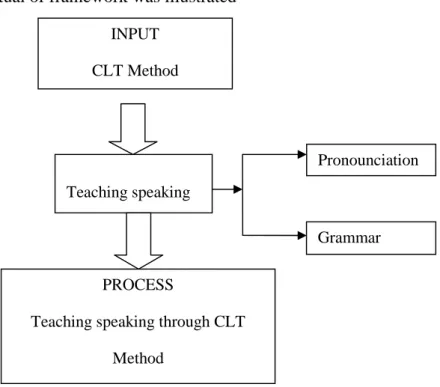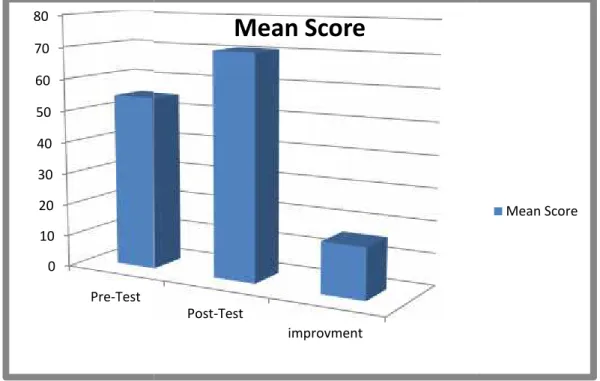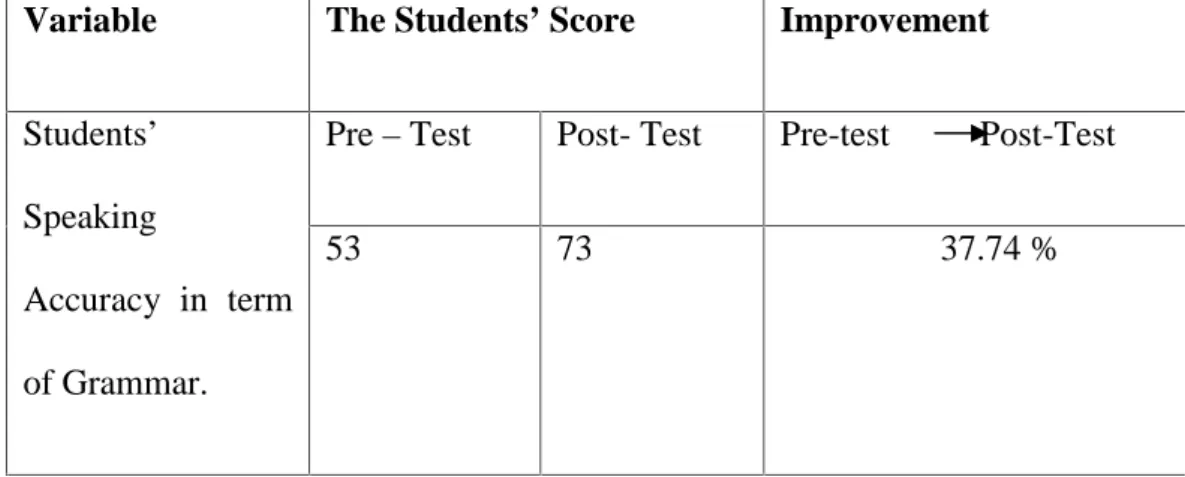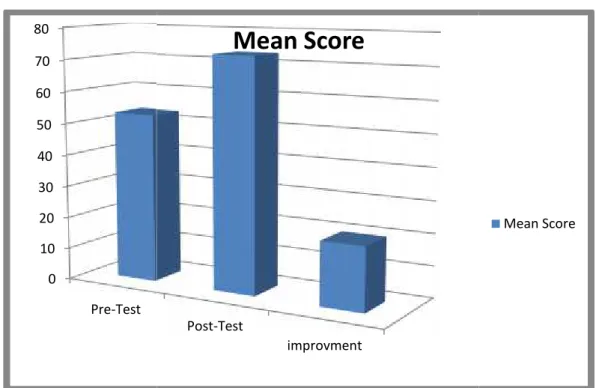CLT) approach in developing students' speaking skills in eight years of SMP Kartika XX-2 Wirabuan. The aim of the research was to determine the effectiveness of the Communicative Language Teaching (CLT) approach in developing the speaking abilities of SMP XX-2 Kartika Wirabuan students. The researcher used a pre-experimental research with one group pre-test and post-test design. . The subjects of the research were students of the eighth year of SMP Kartika XX-2 Wirabuan in the academic year 2016-2017.
Therefore, the researcher concluded that the use of communicative language teaching (CLT) approach was effective in developing students' speaking ability. Alhamdulliahi Robbil Alamin, the researcher expresses her sincere gratitude to the almighty God, Allah SWT, who gave her guidance, grace and good health to complete the writing of this thesis entitled “An Effective Communicative Language Teaching (CLT) Approach in Developing Students' Speaking Ability in to the eighth year of SMP Kartika XX-2. Sincere thanks to all the lecturers of FKIP UNISMUH, especially the lecturers of the Department of English for their guidance during my studies.
But in reality, most of the students did not practice English in the language conversation.
Problem Statement
Objective of the study
Signifance of the study
Scope of the study
This research has provided a valuable contribution to the next researcher in conducting a similar research study. In this part, the writer cites relevant research that allows to increase the reader's interesting view on the effect of the communication approach on speaking ability. The study was conducted by Hisan (2005) in the research he found that the speaking ability in using English is through a process approach by telling a story.
However, the research's conclusions also describe the students who live far from the tourism area. In relation to the students' speaking ability to differentiate with Hirsan that the population research is students who live in or close to tourism and students who do not live in or far from a tourism area. Asmi (2013) found in the thesis by the title that the socio-affective strategy is essential to improve students' accuracy and fluency.
Young (2008) in her journal (Instructional Activities – Hot Seat), said that "Hot Seat" can give the students opportunities to communicate authentically in English, to practice targeted grammatical structures or vocabulary, and to catch up.
Some Pertinent Ideas 1. The concept of speaking
Communicative Language Teaching
Richards (2006) stated that communicative language teaching can be understood as a set of principles about the goals of language teaching, how students learn a language, types of classroom. CLT is the name given to a group of languages to teach, but it is also the change of emphasis in the way of teaching. The "what to learn" aspect of the communicative approach emphasized the importance of language forms being appropriate in a variety of contexts and for different purposes.
The 'how to teach' aspect of the communicative approach is closely related to the idea that language learning takes care of itself and that abundant exposure to the language being used and sufficient opportunities to use it are critical to the development and skills of students. (1998:84) CLT strives to consider communicative competence as the goal of language teaching and to develop techniques and procedures for teaching language skills that are based on interdependent aspects of language and communication. Grammatical competence refers to the knowledge we have of a language which is responsible for our ability to produce sentences in a language. According to Breen and Candlin (1980), given the emphasis in CLT on the communication process rather than on the mastery of language forms, there are different roles of students in the classroom.
Richards, (2001) asserts that there are different types of exercises and activities in the communication approach which “enable students to achieve the communicative objectives of the curriculum and engage students in communication.
Conceptual Framework
Hypothesis
The method in this research was a pre-experimental design with a one-group pre-test design consisting of one class. The researcher greeted and introduced himself, told the students what they were going to learn and why it was important, and explained the technique they were involved in the learning process. Before the simulation used in the classroom, the teacher introduced the rule, procedures, scoring of the decision.
The researcher gave a post test that was the same as with pro test to determine if there was an improvement of.
Variable and Indicators
Instrument of The Research
Procedure of Collecting Data
The researcher gave to the students speaking test about their friends family; it was the same in the pre-test. It aimed to find out the value of treatment, whether the result of the post-test was better than the pre-test.
Technique of Data Analysis
The data of the students' speaking abilities were collected live by the instrument (tests) and analyzed by tabulation, percentage, classification, mean score calculation, post-test value to measure the significant improvement between pre-test and post-test. The researcher used a formula to calculate the average score of the students before and after the test. To find a significant difference between the pre-test and post-test score, the researcher would calculate the test value using the following formula.
After the researcher finds the value of t-test, finds t-table, the value of t-test and t-table will be compared. If the t-test value was greater than the t-table, it meant that there was a significant difference between the pre-test and the post-test. But if the value of the t-table was greater than the t-test, the effectiveness of the communicative language teaching method in the classroom was not good, because there was no significant difference between the pre-test and the post-test.
This chapter consists of two sections, research findings and discussion of research findings. The research finding covered the result of the collected data on the improvement of students' speaking accuracy in terms of pronunciation, and the research discussion includes further explanation of the findings. The average score and improvement of students' speaking accuracy in terms of pronunciation can be seen in the table below.
To clearly see the improvement of the students' speaking accuracy in terms of pronunciation, the following diagram is presented. The above chart shows that there is an improvement in students' speaking accuracy in terms of pronunciation from the pre-test with an average score of 54.5 to the post-test with an average score of 70.5. The improvement compared to the pre-test and the post-test is therefore the same. 16.
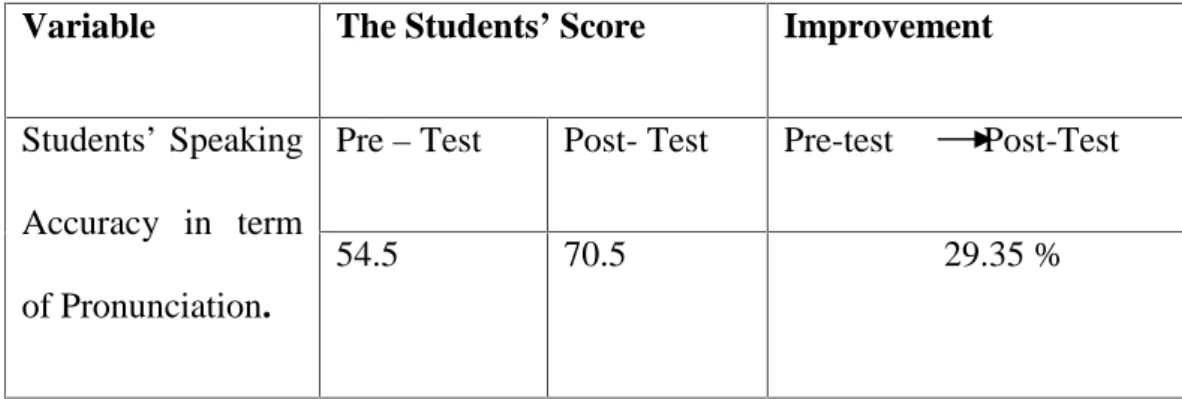
Mean Score
Hypothesis Testing
The graph above shows that there is improvement in students' speaking accuracy in terms of grammar from the pre-test with the average score of 53 to the post-test with the average score of 73, so the improvement from pre-test to post-test is 20. To know if the average score difference of two tests (pre-test and post-test), the researcher used the t-table. If the t-test value is greater than the t-table at the level of significance 0.05 and degree of freedom 20, then the alternative hypothesis (H1) will be accepted and null hypothesis (H0) will be rejected.
Conversely, if the t-test value were less than the t-table at the significance level 0.05 and degree of freedom 20, the alternative hypothesis would be rejected.
Discussion
Based on the previous finding, the researcher would like to compare both results, but before that, the researcher made observation on eight grade SMP Kartika XX-2 Wirabuana. In fact, the students still faced some problems, such as their ability to understand text was low, they could not understand the speaking text, could not understand the author's idea, they were very lazy to answer the speaking test, etc. There were some factors why it was difficult for students to understand the speaking text, according to Harmer (1991:46) “communication between people is an extremely complex and ever-changing phenomenon.
Thus, by dealing with the problem above, the researcher was expected to help the students to improve their speaking skill by using pronunciation and grammar. First, the researcher gave the pre-test in the first meeting to the students using speaking test. Thus, the assessment of the students' speaking skills was based on the result of the pre-test below standard.
During the treatment, the researcher learned to improve the students' speaking ability through the four corners strategy. According to Stanley and Aligin Syafriyani explain that the four corners is a quick strategy that can be used effectively in the formative assessment process to assess student understanding. Finally, the researcher did the post-test to recognize the students' speaking ability after using the four corners strategy, and the result from the students' speaking test showed that the assessment of each students' speaking ability was approaching the standard.
It was shown by the improvement of the mean score from 54.5 in the pretest which was classified as poor to 70.5 in the posttest which was classified as fair. In order for the student to improve speaking accuracy, focus on pronunciation and have high scores in the subsequent test. It was shown by the improvement in mean score from 53 in the pretest which was classified as poor to 73 in the posttest which was classified as fair.
So that the student can improve their speaking accuracy focus on grammar and they achieved a high score in the post-test. Conclusion presents the finding of this research based on the data analysis and discussion in previous chapter, while proposal deals with what the researcher recommends to do.
Conclusions
Suggestion
- The improvement of the students’ score in terms of grammar
- Do you like holiday with your family?Which one place do you like if you holiday with your family? Why do you choose this
- What is her /his father job?
- What is her/his mother name?
- What is her/his mother job?
- What is her/his hobbies?
- Tujuan Pembelajaran
- Materi Pembelajaran
- Sumber Belajar dan Sarana 1. Sumber Belajar
- Tes lisan
- Tes tertulis
2010. Communicative Language Teaching at the Secondary Level of Bangladesh, Teachers' and Learners' Perceptions. Thesis of BRAe University, Dhaka, Bangladesh. Khaerat, 2011. Enhancing students' speaking ability through metocognitive strategies in second year students smpnegeripallanggakab.Gowa.ThesisUnismuh. Effectiveness of social-affective strategy in improving students' speaking ability. Thesis. UNISMUH MAKASSAR.
A Dissertation from Muhammadiyah Makassar University Syam Jaya, 2011: Improving Students' Speaking Ability Through Community Interaction Activities. The Correlation Between Fluency in Speaking English and Vocabulary Mastery of Second Year Students in Madrasah AliyahPutriAs'adiyah. D = The sum of the total difference scores D2 = The square of the sum of the difference scores N = The total number of students.
Do you like vacationing with your family? Which one place do you like when you vacation with your family?
